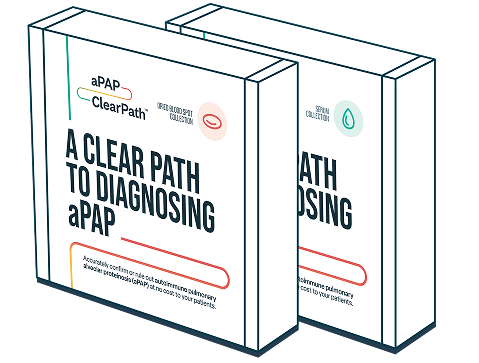

Diagnosing aPAP
Autoimmune pulmonary alveolar proteinosis (aPAP) is often misdiagnosed because its symptoms mimic more common respiratory conditions like pneumonia, bronchitis, and asthma. Because aPAP is so rare, many doctors may have never diagnosed or treated it before, which can delay an accurate diagnosis, on average, by 18 months.
Misdiagnoses may continue until failure to respond to therapy prompts reconsideration and further diagnostic testing. When patients are misdiagnosed, they are at risk of inappropriate treatment and poorer outcomes.
Since many pulmonologists are not familiar with testing for aPAP specifically, they may suggest invasive tests that could require hospitalization, such as bronchoscopy or a lung biopsy. These tests can disrupt a patient’s daily activities, thereby negatively impacting their quality of life.
On a computerized tomography (CT) scan, aPAP appears as ground-glass opacification with a “crazy paving” pattern – a nonspecific sign with a wide etiology, including infection, pulmonary edema, chronic interstitial disease, and acute alveolar injuries. A clinical history of slowly progressive dyspnea, with or without cough and fatigue, together with the characteristic high-resolution CT findings, should prompt the consideration of aPAP.
When you see:
-

Common chronic pulmonary symptoms
-

-

An abnormal CT scan
-

-

Other pulmonary infection diagnoses that are refractory to treatment
Then it is time to test for GM-CSF autoantibodies.
When diagnosing aPAP, a simple and accurate GM-CSF autoantibody blood test instead of an invasive bronchoscopy or lung biopsy may help patients obtain a definitive diagnosis sooner.
The presence of high levels of GM-CSF autoantibodies in serum is used to differentiate aPAP from other PAP-causing diseases, which are indistinguishable based on clinical presentations, radiology, and histopathology.
Guide to the differential diagnosis of aPAP
Reprinted with permission of the American Thoracic Society. Copyright © 2024 American Thoracic Society. All rights reserved. McCarthy C, Carey BC, Trapnell BC. Autoimmune pulmonary alveolar proteinosis. Am J Respir Crit Care Med. 2022;205(9):1016-1035. doi:10.1164/rccm.202112-2742SO. The American Journal of Respiratory and Critical Care Medicine is an official journal of the American Thoracic Society.Savara Inc. has launched the aPAP ClearPathTM Testing Program with the goal of improving the understanding of the signs and symptoms of rare respiratory diseases, including pulmonary alveolar proteinosis (PAP), and educating physicians about the clinical benefits of early testing as a diagnostic tool to confirm or rule out autoimmune PAP (aPAP).
As part of the program, healthcare professionals can order a simple, accurate, and noninvasive blood test for eligible patients.1,2
This blood test is provided at no charge to the patient, the healthcare professional, or third-party payers.

See how Savara is working to change the treatment landscape.
Learn about MOLBREEVI**MOLBREEVI is the FDA and EMA conditionally accepted trade name for molgramostim inhalation solution. It is not approved in any indication.